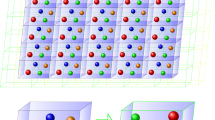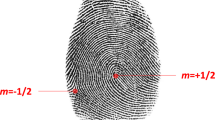Abstract
We propose an electro-mechanically coupled phase-field model for ferroelectric materials that show cubic–tetragonal phase transition. The cubic phase is idealized by an isotropic formulation, and the tetragonal phase is idealized by a transversely isotropic formulation. We consider a classical phase-field model with Ginzburg–Landau-type evolution of the order parameter. The order parameter drives the transition of all involved moduli tensors such as elastic, dielectric and piezoelectric moduli, which in turn maintain their typical features and stability as a result of a selected phase-transition function. The model is described in coordinate-invariant form and implemented into a finite element framework with implicit time integration of the evolution equation. Representative numerical examples in two and three dimensions demonstrate the main features of the constitutive model and the numerical stability of the formulation.







Similar content being viewed by others
Notes
For brevity, we neglect all volumetric sources such as mechanical body forces and free electric charges.
Please note that the realistic grain size of ferroelectrics is much larger. We have selected such small dimensions for the purpose of demonstration only. With the given dimensions, the material is provided with enough freedom to find some suitable domain configuration (the domain-wall width of barium titanate is approximately 1.5 nm).
Note that in this example, we deliberately assume a smooth transition of the spontaneous polarization across grain boundaries. A computational analysis of associated implications is given in [31].
We note that depending on the size of the sample, the proposed model predicts domain configurations with more complex patterns. As such phenomena seem rather unusual in experiments and computations [43,44,45,46], the associated implications are a part of the current research. For the phase-field analysis of size effects in ferroelectrics, we refer to [47,48,49].
References
Xu, Y.: Ferroelectric Materials and Their Applications. Elsevier, Amsterdam (2013)
Fetisov, Y.K., Bush, A.A., Kamentsev, K.E., Ostashchenko, A.Y., Srinivasan, G.: Ferrite-piezoelectric multilayers for magnetic field sensors. IEEE Sens. J. 6(4), 935–938 (2006)
Bibes, M., Barthélémy, A.: Multiferroics: towards a magnetoelectric memory. Nat. Mater. 7(6), 425 (2008)
Spaldin, N.A., Fiebig, M.: The renaissance of magnetoelectric multiferroics. Science 309(5733), 391–392 (2005)
Nan, C.-W., Bichurin, M.I., Dong, S., Viehland, D., Srinivasan, G.: Multiferroic magnetoelectric composites: historical perspective, status, and future directions. J. Appl. Phys. 103(3), 1 (2008)
Schröder, J., Labusch, M., Keip, M.-A.: Algorithmic two-scale transition for magneto-electro-mechanically coupled problems: \(\text{ FE }^{2}\)-scheme: localization and homogenization. Comput. Methods Appl. Mech. Eng. 302, 253–280 (2016)
Von Hippel, A.: Ferroelectricity, domain structure, and phase transitions of barium titanate. Rev. Mod. Phys. 22(3), 221 (1950)
Arlt, G., Hennings, D., de With, G.: Dielectric properties of fine-grained barium titanate ceramics. J. Appl. Phys. 58(4), 1619–1625 (1985)
Frey, M., Payne, D.: Nanocrystalline barium titanate: evidence for the absence of ferroelectricity in sol-gel derived thin-layer capacitors. Appl. Phys. Lett. 63(20), 2753–2755 (1993)
Zgonik, M., Bernasconi, P., Duelli, M., Schlesser, R., Günter, P., Garrett, M.H., Rytz, D., Zhu, Y., Wu, X.: Dielectric, elastic, piezoelectric, electro-optic, and elasto-optic tensors of \(\text{ BaTiO }_3\) crystals. Phys. Rev. B 50(9), 5941 (1994)
Toupin, R.A.: The elastic dielectric. J. Ration. Mech. Anal. 5(6), 849–915 (1956)
Eringen, A.C.: On the foundations of electroelastostatics. Int. J. Eng. Sci. 1(1), 127–153 (1963)
Maugin, G.: Continuum Mechanics of Electromagnetic Solids, vol. 33. North-Holland, Amsterdam (1988)
Eringen, A.C., Maugin, G.A.: Electrodynamics of Continua. Springer, New York (1990)
Kovetz, A.: Electromagnetic Theory. Oxford University Press, Oxford (2000)
Hwang, S.C., Lynch, C.S., McMeeking, R.M.: Ferroelectric/ferroelastic interactions and a polarization switching model. Acta Metall. Mater. 43(5), 2073–2084 (1995)
Huber, J.E., Fleck, N.A., Landis, C.M., McMeeking, R.M.: A constitutive model for ferroelectric polycrystals. J. Mech. Phys. Solids 47(8), 1663–1697 (1999)
Huber, J.E., Fleck, N.A.: Multi-axial electrical switching of a ferroelectric: theory versus experiment. J. Mech. Phys. Solids 49(4), 785–811 (2001)
Kamlah, M.: Ferroelectric and ferroelastic piezoceramics-modeling of electromechanical hysteresis phenomena. Contin. Mech. Thermodyn. 13(4), 219–268 (2001)
Landis, C.M.: Non-linear constitutive modeling of ferroelectrics. Curr. Opin. Solid State Mater. Sci. 8(1), 59–69 (2004)
Schröder, J., Gross, D.: Invariant formulation of the electromechanical enthalpy function of transversely isotropic piezoelectric materials. Arch. Appl. Mech. 73(8), 533–552 (2004)
Rosato, D., Miehe, C.: Dissipative ferroelectricity at finite strains. Variational principles, constitutive assumptions and algorithms. Int. J. Eng. Sci. 74, 163–189 (2014)
Zhang, W., Bhattacharya, K.: A computational model of ferroelectric domains. Part I: model formulation and domain switching. Acta Mater. 53(1), 185–198 (2005)
Su, Y., Landis, C.M.: Continuum thermodynamics of ferroelectric domain evolution: theory, finite element implementation, and application to domain wall pinning. J. Mech. Phys. Solids 55(2), 280–305 (2007)
Schrade, D., Müller, R., Xu, B.X., Gross, D.: Domain evolution in ferroelectric materials: a continuum phase field model and finite element implementation. Comput. Methods Appl. Mech. Eng. 196(41), 4365–4374 (2007)
Zhang, W., Bhattacharya, K.: A computational model of ferroelectric domains. Part II: grain boundaries and defect pinning. Acta Mater. 53, 199–209 (2005)
Choudhury, S., Li, Y.L., Krill III, C.E., Chen, L.-Q.: Phase-field simulation of polarization switching and domain evolution in ferroelectric polycrystals. Acta Mater. 53(20), 5313–5321 (2005)
Choudhury, S., Li, Y.L., Krill III, C.E., Chen, L.-Q.: Effect of grain orientation and grain size on ferroelectric domain switching and evolution: phase field simulations. Acta Mater. 55(4), 1415–1426 (2007)
Chen, L.-Q.: Phase-field method of phase transitions/domain structures in ferroelectric thin films: a review. J. Am. Ceram. Soc. 91(6), 1835–1844 (2008)
Kontsos, A., Landis, C.M.: Phase-field modeling of domain structure energetics and evolution in ferroelectric thin films. J. Appl. Mech. 77(4), 041014 (2010)
Völker, B., Kamlah, M.: Large-signal analysis of typical ferroelectric domain structures using phase-field modeling. Smart Mater. Struct. 21(055013), 1–10 (2012)
Vidyasagar, A., Tan, W.L., Kochmann, D.M.: Predicting the effective response of bulk polycrystalline ferroelectric ceramics via improved spectral phase field methods. J. Mech. Phys. Solids 106, 133–151 (2017)
Völker, B., Marton, P., Elsässer, C., Kamlah, M.: Multiscale modeling for ferroelectric materials: a transition from the atomic level to phase-field modeling. Contin. Mech. Thermodyn. 23(5), 435–451 (2011)
Völker, B., Landis, C.M., Kamlah, M.: Multiscale modeling for ferroelectric materials: identification of the phase-field model’s free energy for PZT from atomistic simulations. Smart Mater. Struct. 21(3), 035025 (2012)
Schrade, D., Müller, R., Gross, D.: On the physical interpretation of material parameters in phase field models for ferroelectrics. Arch. Appl. Mech. 83(10), 1393–1413 (2013)
Schrade, D., Müller, R., Gross, D., Keip, M.-A., Thai, H., Schröder, J.: An invariant formulation for phase field models in ferroelectrics. Int. J. Solids Struct. 51(11), 2144–2156 (2014)
Schrade, D., Müller, R., Gross, D., Steinmann, P.: Phase field simulations of the poling behavior of \(\text{ BaTiO }_3\) nano-scale thin films with \(\text{ SrRuO }_3\) and Au electrodes. Eur. J. Mech. A Solids 49, 455–466 (2015)
Keip, M.-A., Schrade, D., Thai, H., Schröder, J., Svendsen, B., Müller, R., Gross, D.: Coordinate-invariant phase field modeling of ferro-electrics, part II: application to composites and poly-crystals. GAMM Mitt. 38(1), 115–131 (2015)
Taylor, R.L.: FEAP—Finite Element Analysis Program. University of California, Berkeley (2014)
Alnæs, M.S., Blechta, J., Hake, J., Johansson, A., Kehlet, B., Logg, A., Richardson, C., Ring, J., Rognes, M.E., Wells, G.N.: The FEniCS project version 1.5. Arch. Numer. Softw. 3(100), 9–23 (2015)
Zäh, D., Miehe, C.: Computational homogenization in dissipative electro-mechanics of functional materials. Comput. Methods Appl. Mech. Eng. 267, 487–510 (2013)
Sridhar, A., Keip, M.-A., Miehe, C.: Homogenization in micro-magneto-mechanics. Comput. Mech. 58(1), 151–169 (2016)
Lahoche, L., Luk’Yanchuk, I., Pascoli, G.: Stability of vortex phases in ferroelectric easy-plane nano-cylinders. Integr. Ferroelectr. 99(1), 60–66 (2008)
Naumov, I., Bratkovsky, A.M.: Unusual polarization patterns in flat epitaxial ferroelectric nanoparticles. Phys. Rev. Lett. 101(10), 107601 (2008)
Rodriguez, B., Gao, X., Liu, L., Lee, W., Naumov, I., Bratkovsky, A., Hesse, D., Alexe, M.: Vortex polarization states in nanoscale ferroelectric arrays. Nano Lett. 9(3), 1127–1131 (2009)
Seidel, J.: Topological Structures in Ferroic Materials. Springer, Cham (2016)
Wang, J., Zhang, T.-Y.: Size effects in epitaxial ferroelectric islands and thin films. Phys. Rev. B 73(14), 144107 (2006)
Balakrishna, A., Huber, J.: Scale effects and the formation of polarization vortices in tetragonal ferroelectrics. Appl. Phys. Lett. 106(9), 092906 (2015)
Schrade, D., Keip, M.-A., Thai, H., Schröder, J., Svendsen, B., Müller, R., Gross, D.: Coordinate-invariant phase field modeling of ferro-electrics, part I: model formulation and single-crystal simulations. GAMM Mitt. 38(1), 102–114 (2015)
Acknowledgements
O.N. and M.A.K. acknowledge the financial support of the German Research Foundation (DFG) within the Cluster of Excellence in Simulation Technology (EXC 310). W.D. and R.M. were partially supported by the DFG within Research Group FOR 1509 (MU 1370/8-2).
Author information
Authors and Affiliations
Corresponding author
Additional information
Publisher's Note
Springer Nature remains neutral with regard to jurisdictional claims in published maps and institutional affiliations.
Rights and permissions
About this article
Cite this article
Nadgir, O., Dornisch, W., Müller, R. et al. A phase-field model for transversely isotropic ferroelectrics. Arch Appl Mech 89, 1057–1068 (2019). https://doi.org/10.1007/s00419-019-01543-y
Received:
Accepted:
Published:
Issue Date:
DOI: https://doi.org/10.1007/s00419-019-01543-y




